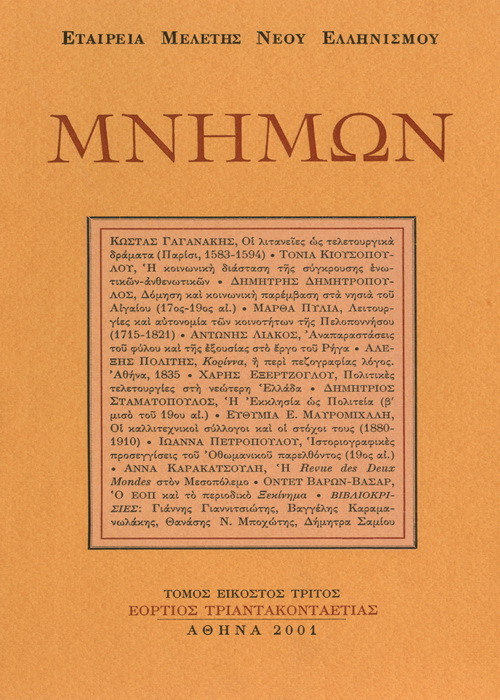Η ΕΚΚΛΗΣΙΑ ΩΣ ΠΟΛΙΤΕΙΑ. ΑΝΑΠΑΡΑΣΤΑΣΕΙΣ TOΥ ΟΡΘΟΔΟΞΟΥ ΜΙΛΛΕΤ ΚΑΙ ΤΟ ΜΟΝΤΕΛΟ ΤΗΣ ΣΥΝΤΑΓΜΑΤΙΚΗΣ ΜΟΝΑΡΧΙΑΣ (δεύτερο μισό 19ου αι.)
Abstract
Dimitrios Stamatopoulos, The Church as State: representations of the Orthodoxmillet and the model of constitutional monarchy (second half of thenineteenth century)
The institutionalised introduction of secular elements into the administrationof the Patriarchate of Constantinople after the ratification ofthe General Regulations (1860-1862) created the conditions for the emergenceof a discourse aimed at the internal reorganization of ecclesiasticalinstitutions based on the state model. This model was adopted not onlyby reform-minded circles but also by representatives of the clericalistwing, each with completely different political aims. The model of constitutionalmonarchy appeared as the most «functional» for solving thecentral political problem posed by the clericalist wing in the discussion:how could a regime of patriarchal centralization be applied without confutingthe essence of reform. This model of constitutionality prevailednot only because the reformers preferred it as an alternative version ofrestructuring the millet but because the clericalists espoused and promotedit in the form of a state model: that of the constitutional monarchy.And their aim was not only to prevent the domination of thelay element but also to avoid the formation of a public sphere, whichin any case in Eastern and Southeastern Europe was inherent in theemergence of a discourse on nation and nationalism.
Article Details
- How to Cite
-
ΣΤΑΜΑΤΟΠΟΥΛΟΣ Δ. (2001). Η ΕΚΚΛΗΣΙΑ ΩΣ ΠΟΛΙΤΕΙΑ. ΑΝΑΠΑΡΑΣΤΑΣΕΙΣ TOΥ ΟΡΘΟΔΟΞΟΥ ΜΙΛΛΕΤ ΚΑΙ ΤΟ ΜΟΝΤΕΛΟ ΤΗΣ ΣΥΝΤΑΓΜΑΤΙΚΗΣ ΜΟΝΑΡΧΙΑΣ (δεύτερο μισό 19ου αι.). Mnimon, 23, 183–220. https://doi.org/10.12681/mnimon.711
- Issue
- Vol. 23 (2001)
- Section
- ARTICLES



